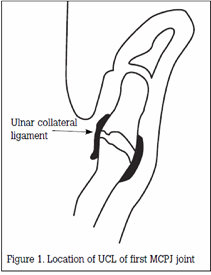Thumb Ulnar Collateral Ligament (UCL) Injury
The ulnar collateral ligament is a band of tough, elastic tissue that attaches to the middle joint of the thumb, the joint next to the first web space. The specific role of this ligament is to prevent the thumb from side to side movement.
Mechanism of Injury
Injury to the UCL is fairly common. The term ‘gamekeeper’s thumb’ and ‘skiers thumb’ are used to describe this injury and are often used interchangeably, although they have slightly different injury patterns. Skier’s thumb is used to describe an acute injury to the UCL. When a skier falls with their hand out on a ski pole, the thumb can be caught during the fall and pulled away from the hand – resulting in significant stressors being placed on the UCL. The ligament may tear away from the bone if it is pulled away far enough. There are many other ways to acutely injure this ligament, but skier’s thumb is the name used as it is one of the most common injuries to skiers. Gamekeepers thumb refers to a chronic pattern of injury that leads to loosening of the ligament over time. The name comes from Scottish gamekeepers who would kill their game by grasping the head of the animal between their thumb and index finger to break its neck. Over time the repetitive stress to the ligament causes it to stretch – and pain at the thumb results.

Dependant on the degree of force applied through the UCL a number of different injuries can occur anatomically. The mildest form of injury is when the UCL is stretched or strained. With increased force the UCL can tear partially or completely. In complete tears it is very common for an avulsion fracture to occur. This is when a piece of bone that the ligament attaches to is pulled off the middle bone in the thumb. If the UCL is pulled away from its attachment site it is highly unlikely that it will be able to heal spontaneously.
Symptoms
Patients typically present with pain, swelling and bruising over the site of the UCL at the base of the thumb, with the severity of symptoms related to the extent of the injury. They may find it hard to grasp objects, or complete tasks that involve the use of the thumb e.g. tying shoelaces or turning a key.
Treatment
If you are experiencing any of the symptoms above, please contact our clinic.